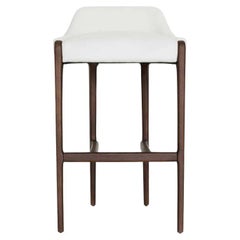Moka Counter Stool
Recent Sales
21st Century and Contemporary Portuguese Modern Club Chairs
Hardwood, Beech, Boxwood, Cherry, Chestnut, Ebony, Mahogany, Oak, Palisa...
21st Century and Contemporary Portuguese Modern Club Chairs
Fabric, Wood
A Close Look at modern Furniture
The late 19th and early 20th centuries saw sweeping social change and major scientific advances — both of which contributed to a new aesthetic: modernism. Rejecting the rigidity of Victorian artistic conventions, modernists sought a new means of expression. References to the natural world and ornate classical embellishments gave way to the sleek simplicity of the Machine Age. Architect Philip Johnson characterized the hallmarks of modernism as “machine-like simplicity, smoothness or surface [and] avoidance of ornament.”
Early practitioners of modernist design include the De Stijl (“The Style”) group, founded in the Netherlands in 1917, and the Bauhaus School, founded two years later in Germany.
Followers of both groups produced sleek, spare designs — many of which became icons of daily life in the 20th century. The modernists rejected both natural and historical references and relied primarily on industrial materials such as metal, glass, plywood, and, later, plastics. While Bauhaus principals Marcel Breuer and Ludwig Mies van der Rohe created furniture from mass-produced, chrome-plated steel, American visionaries like Charles and Ray Eames worked in materials as novel as molded plywood and fiberglass. Today, Breuer’s Wassily chair, Mies van der Rohe’s Barcelona chair — crafted with his romantic partner, designer Lilly Reich — and the Eames lounge chair are emblems of progressive design and vintage originals are prized cornerstones of collections.
It’s difficult to overstate the influence that modernism continues to wield over designers and architects — and equally difficult to overstate how revolutionary it was when it first appeared a century ago. But because modernist furniture designs are so simple, they can blend in seamlessly with just about any type of décor. Don’t overlook them.
Finding the Right club-chairs for You
Traditionally covered in leather and abundantly luxurious, antique and vintage club chairs are among the most comfortable pieces of furniture that you could ever bring into your living room. The classic club chair is one of the 52 types of chairs to know when decorating your home.
While the club chair was especially popular in France during the 1920s — known there as fauteuil confortable (or “comfortable armchair”) — modern versions are derived from those used in 19th-century English gentlemen’s clubs, which is believed to be the origin of their name. A riff on the traditional armchair, these seats typically have low backs, extra-wide armrests and more than sufficient padding to support extended lounging.
Well-known modern interpretations of the club chair can be found in Marcel Breuer’s pared-down Wassily lounge chair and in the cube-like seats of the LC collection, designed by Charles-Édouard “Le Corbusier” Jeanneret, Pierre Jeanneret and Charlotte Perriand. Debuting in 1956, the celebrated Eames lounge chair was a fresh, subversive new take on the classic English club chair and a culmination of experimentation by Charles and Ray Eames, its inventive creators.
When shopping for any style of club chair, be it a mid-century modern club chair, an Art Deco club chair or another type, you’ll want to think about the room you have in mind for this distinct seating. Club chairs occupy a lot of real estate, as they’re usually larger than standard chairs. (You’ll want to make certain that there is at least one foot of space around the chair, for example, to ensure the sitter doesn’t feel cramped and that there is room to move freely around the furnishing.) And although they were originally upholstered in leather, contemporary iterations of the club chair can be found in fabric and plastic.
Introduce a decadent atmosphere and a whole lot of comfort in your living room or reading nook. Explore a collection of antique, new and vintage club chairs on 1stDibs.

